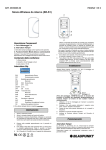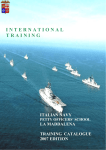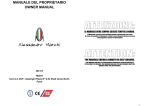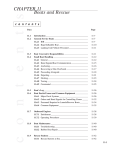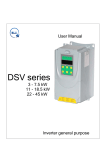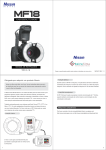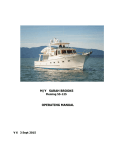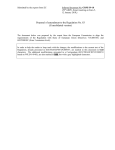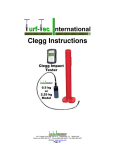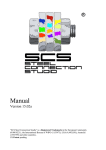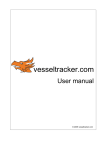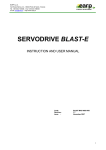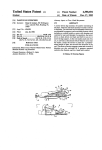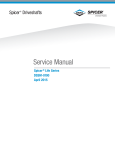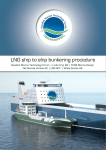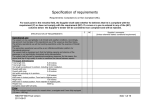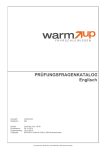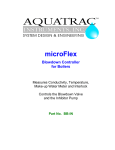Download Manuale Joker inglese 2
Transcript
JOKER BOAT Srl OWNER’S MANUAL english 2 • CANTIERE: JOKER BOAT Srl Via S. Maria 98 - 20093 COLOGNO MONZESE (MI) INDEX • INTRODUCTION: • REGULATIONS AND DANGER LEVELS: • SECTION 1: • SECTION 2: • SECTION 3: • SECTION 4: • SECTION 5: • SECTION 6: • SECTION 7: • SECTION 8: EC Certification and Main Features. Instructions for Inflating Safety Regulations How to Manage The Boat Indications on Sailing The Boat Instructions for Cleaning, Repairing and Laying-up Plant Diagrams Warranty • WARRANTY STATEMENT Pag. 4 Pag. 5 ENGLISH OWNER MANUAL Pag. 6-11 Pag. 12 Pag. 13-21 Pag. 22-30 Pag. 31-37 Pag. 38-43 Pag. 44-53 Pag. 54-56 Pag. 57-63 3 ENGLISH INTRODUCTION 4 The manufacturer thanks you for your preference in purchasing this model of boat:“Joker Boat” Rest assured that your choice is supported by the quality of this product, which will undoubtedly meet your requirements. Our boat was built in compliance with European Regulations for both design and assembly, which is the Manufacturer’s standard. Moreover the “Joker Boat“ dinghy was designed to ensure its buoyancy, and partial navigation, even if the tubes are deflated or damaged, since it combines boat quality with inflatable dinghy advantages. This manual was written to help you sail safely and enjoy your dinghy. It contains information regarding the boat, its plants and apparatus supplied and installed, with functioning and maintenance. Before using your boat please read this manual carefully in order to become acquainted with it. If this is your first boat or if you are moving on to a type of boat that you are not familiar with, for your comfort and safety, ensure that you have acquired handling experience and practice before taking command. REGULATIONS AND DANGER LEVELS • Reference Regulations: • ISO 10240 DANGER LEVELS ENGLISH • ISO 8999 e ISO 11192 Regulation relative to Owner Manual texts. Regulations relative to the definition of ISO pictograms to be applied on diagrams/plants. The manual contains notes, identified as shown below, which contain instructions relative to safety or to environmental health. Read and DO NOT NEGLECT TO APPLY THEM. DANGER A note like this indicates that there is a serious risk that is likely to cause death or permanent serious injury, if appropriate precautions are not taken. WARNING A note like this indicates the existence of a risk that may cause death or injury if appropriate precautions are not taken. ATTENTION A note like this indicates reference to the application of safety or environmental protection practices,or draws attention to unsafe behaviour that might cause injury to persons or damage to the craft,its components or the environment. 5 SECTION 1 ENGLISH EC CERTIFICATION AND MAIN FEATURES The EC marking indicates that the inflatable craft was built in compliance with the “European Directive 94/25 CE”applied to pleasure craft. BEAUFORT WIND SCALE AND CORRESPONDING STATE OF THE SEA AFTER A FEW HOURS OF WIND AWAY FROM THE COAST. Force Denomination Knots Km/h mt/sec State of the sea and wave height,in metres. 0 Calm <1 <1 0–0,2 Calm 1 Light air 1–3 1-5 0,3-1,5 2 Light breeze 4-6 6-11 1,6-3,3 3 Gentle breeze 7-10 12-19 3,4-5,4 4 Moderate breeze 11-16 20-28 5 Strong breeze 17-21 6 Fresh wind 7 Almost calm 0,2 5,5-7,9 Small waves 0,5 29-38 8,0-10,7 Large waves 1,25 22-27 39-49 10,8-13,8 Strong wind 28-33 50-61 13,9-17,1 Very large waves 8 Gale 34-40 62-74 17,2-20,7 Rough sea 4 9 Strong gale 41-47 75-88 20,8-24,4 Very rough sea 6 10 Storm 48-55 89-102 24,5-28,4 Heavy 9 11 Violent storm 56-63 103-117 28,5-32,6 Very heavy 14 12 Hurricane 64 over 118 over 32,7 over Stormy REMEMBER: CAT. PROG. CAT. PROG. CAT. PROG. CAT. PROG. 6 0 “A” = NO LIMITS “B” = FORCE 8 WINDS – WAVES UP TO 4 METRES “C” = FORCE 6 WINDS – WAVES UP TO 6 METRES “D” = FORCE 4 WINDS – WAVES UP TO 0.5 METRES 2,0 2,5 14 over CERTIFYING BODY: Italian Naval Register (RINA) Via Corsica, 12 16128 - Genoa ITALY • ISO 14945 Manufacturer Plate: The Manufacturer Plate is always located in a clearly visible position, for instance near the dashboard, and must never be removed or tampered with. - Name of Manufacturer - Address JOKER BOAT Srl Via S. Maria, 98 20093 Cologno Monzese -Type of assessment - Design Category - Max transportable weight - Type A + a .................................... ............................................. Kg......................................... ............................................. ENGLISH Aboard there are a Manufacturer Plate and 2 hull identification plates. 7 ENGLISH HULL IDENTIFICATION NUMBER PLATES ISO 10087 (C.I.N.) There are two hull identification number plates aboard. One is fitted to the right of the stern mirror at least 300 mm from the boat axle.The second plate is resined into a concealed point on the boat of which only the manufacturer knows the whereabouts. THE PLATES MUST NEVER BE MOVED OR TAMPERED WITH. The C.I.N. identifies the following: - Manufacturer Nationality - Manufacturer Code - Serial Number - Month of Construction - Year of Construction - Year of Sale or Use ITALIA........................ JBO ......................... ..................................... ..................................... ..................................... ..................................... IT - J B O ATTENTION It is fundamental for these number plates to be present aboard the boat as they are the only form of recognition and identification for it and without them the craft is not compliant with current legislation.The plates should never be removed, so any tampering or removal not authorised by the boat builder is the full responsibility of the owner. 8 PLANTS YES NO ELECTRICS PLANT FUEL PLANT FIRE-FIGHTING EQUIPMENT OPTIONAL LIFE-SAVING EQUIPMENT OPTIONAL ENGLISH BILGE PLANT 9 ENGLISH MAIN FEATURES ISO 8666 Max Legth Mt. Max width Mt. Max height Mt. Weight of the boat * 315 370 420 470 515 540 580 600 650 3.16 3.63 4.08 4.95 5.30 5.48 5.90 6.01 6.57 1.59 1.67 1.82 2.18 2.23 2.36 2.30 2.51 2.48 0.52 0.55 0.58 0.70 0.77 0.79 0.81 0.86 0.97 53 80 100 250 350 400 320 480 500 1.25 1.35 0.98 1.16 1.38 1.47 1.70 2.10 45 48 52 55 55 55 55 55 4 4 6 6 6 6 5 6 5 6 8 7 10 10 15 16 450 540 720 630 900 900 900 1440 100 83 110 165 96 90 118 166 Full load sisplacement 0.35 t. Tubolars Ø 42 Number of compartments 3 People on board 3 max N° Max weight ( with people on boat) 270 Kg. Tankage lt. Max power advised Kw. 14.7 26.5 37 56 * (Without equipement, liquid, and engine) 10 885 SECTION 2 21’ 23’ 24’ 24’efb 26’ 28’ 28’efb 30’ 33’ 5.60 6.20 6.98 7.46 7.46 7.93 8.50 8.50 9.04 10.00 2.26 2.50 2.58 2.99 2.99 2.99 3.15 3.15 3.15 3.60 0.75 0.89 0.96 1.12 1.12 1.10 1.23 1.23 1.23 2.04 400 450 750 750 1200 900 1200 1500 1900 1.17 1.80 2.20 2.77 2.77 4.60 3.49 3.49 4.40 5.00 52 55 58 62 62 63 64 64 65 78 6 6 6 6 6 6 8 8 8 8 12 12 15 16 16 15 16 16 15 20 1080 1080 1080 1440 1440 1980 1440 1440 1440 2000 100 110 200 390 390 380 590 590 550 770 85 110 166 221 231 221 368 368 442 662 ENGLISH 19’ 11 SECTION 2 ENGLISH INSTRUCTIONS FOR INFLATING/DEFLATING THE TUBES The inflatable dinghy comprises tubes made up of two or more compartments that are not interconnected; valves for inflating/deflating (one per compartment) are maintenance-free since they are kept clean by simply plugging them up to stop dirt obstructing the mechanisms. INFLATING Open the plugs and use the supplied pump to inflate the compartments to “volume”without distinction, but do not pressurise them. Subsequently raise to operating pressure (0.2 Bars) and close the plugs. If the dinghy is left in the sun, check tube pressure; if the pressure is found to be higher than that recommended by the manufacturer, deflate the compartments slightly. WARNING Do not use compressors and/or other types of inflating equipment not approved by the boat builder DEFLATING Unscrew the cap and at the same time press and rotate the inflating valve lock by 90°. To deflate the dinghy tubes completely use the supplied pump by inverting the pump tube connection. 12 SECTION SECTION32 SAFETY REGULATIONS ENGLISH The manual contains recommendations and basic rules of conduct for using the boat in complete safety. Although it is not possible to offer safety information for all potential situations, in general it is recommended that you: • regularly check which safety requirements are in force; • ensure the boat and plants are kept fully efficient; • have the boat inspected by the dealer where it was purchased or by an authorised mechanic at least once a year; • always check weather and seagoing conditions before setting out; • keep the boat fully efficient above all, which means in the state in which it was delivered to you. ANY ACCIDENT INVOLVING THE BOAT OR TO THIRD PARTIES DERIVING FROM MALICE/NEGLECT/NON-COMPLIANT USE OF THE CRAFT, OR FROM MODIFICATIONS TO THE STRUCTURE OR TO EQUIPMENT THAT HAVE NOT BEEN APPROVED BY COMPETENT BODIES AND ARE NOT AUTHORISED BY THE MANUFACTURER, WILL BE THE FULL RESPONSIBILITY OF THE BOAT’S OWNER. FUELLING Procedures to apply before and during fuelling. 1 2 Switch off all electrical devices,including the motor/s,electrical appliances,the blower (vapour extractor),lights etc.etc. Extinguish cigarettes and/or other objects that may produce sparks or flames. 13 SECTION 1 ENGLISH 3 Close all openings,including hatches and portholes if there are any etc.etc. DANGER Fuel vapours are explosive and may linger in the lower part of a craft where they may accidentally ignite. During refuelling operations,keep all hatches and portholes closed. Post–fuelling procedures: 1 2 3 Close the fuel tank cap and clean any spilled fuel. Open all hatches and peaks, portholes and motor housing etc., ensuring by sight and smell whether any vapours/fumes or fuel leaks are present. If there are any leaks and/or vapours, identify and eliminate the cause before starting up the motor/s. If your dinghy is fitted with an awning (e.g.for nautical camping),air it before starting up the motor/s. DANGER Fuel vapours are highly explosive (especially in the case of petrol). In order to avoid the risk of explosion or fire, eye and smell check for any leaks or spillage of fuel, or the presence or accumulation of vapours in the fuel tank area or in the other ports. Before starting up the motors, always run the vapour aspirator for at least 4 minutes 14 SECTION 2 REMEMBER FIRE DANGER ALWAYS WARNING Easily flammable products must not be kept aboard. ENGLISH Fire may be caused by: Crew negligence when smoking,the presence aboard of flammable liquids,electrical contacts,a propulsion motor,errors in fuelling procedure or if maintenance has not be performed as required. Once again,it is important that the crew behave correctly and that the boat is kept in order to avoid serious damage to it and to persons. However, if a fire does occur aboard, switch off motor/s and fuel tank housing extractors immediately, check to see if it is an electrical component or in any case a small-scale fire that does not involve flammable liquids, in which case use a suitable fire extinguisher to try and put the fire out completely. WARNING Extinguishers or any other fire-fighting equipment must not be kept in compartments with key locks, but in easily accessible and clearly indicated locations. If it is a fire that involves the supply system or flammable liquids, there is a greater risk of explosion. If necessary abandon the boat, ensuring that all passengers are wearing lifejackets. If possible, before abandoning the boat, try to inform the rescue unit of your position. 15 SECTION 1 ENGLISH After leaving the boat move away from it QUICKLY and ensure you keep well away from it, since the burning fuel may spread over the surface of the water, in the area around the boat. For the same reason, do not use rescue flares before reaching a safe distance from the boat, in order to avoid explosions. FLOODING/SHIPPING WATER: This boat has been built applying criteria that enable it to face contrary sea and wind conditions. But good skippers should use all their expertise to evaluate sea and weather conditions in order to conduct their pleasure outings in the most responsible possible manner, and should be severely self-critical with regard to their own capabilities. - Flooding/shipping water or capsizing may be caused by various factors, such as having: • ignored sea and weather conditions. • loaded the boat incorrectly. • manoeuvred or docked the boat incorrectly. - If flooding was caused by aft wave action, try to turn the boat and face waves with the prow. - Check that the bilge pumps (if fitted) are operating and assist emptying by using buckets and manual pumps. WARNING If the boat has flooded or is shipping water, it may become unstable and capsize. 16 SECTION 2 ENGLISH - If flooding was caused by hull perforation, use any available object to plug it (rags/cloths/wooden tools etc.) and get back to the nearest port immediately. Remember that this is an inflatable dinghy and even when it floods the risk that it will sink is almost to be excluded (if the compartments are undamaged), so try and keep calm, and empty the water out of the cockpit as soon as possible. Moreover, remember that the cockpit is already fitted with drainage limbers. WARNING Always leave valves and cockpit drainage plugs open during navigation.Do not obstruct cockpit drainage outlets at any time.Do not leave bulky material in front of drainage outlets. Exhaust valve (where fitted) Cockpit drainage limbers 17 ENGLISH SECTION 1 However, when the sea is rough, keep all ports closed, wear lifejackets and try to get into the nearest port. Remember, it is implicit that the boat is the safest place for the crew, so the decision to abandon it must be rooted in extremely serious conditions where it is impossible to steer and there is a serious risk of sinking. In this case (if VHF is available), transmit a MAY DAY message before abandoning the boat, informing the rescue unit of position. Before entering the water, ensure that everyone is wearing a lifejacket and that you have rescue flare signals with you and that you launch one immediately; in fact, when the sea is rough it is not always possible to identify another boat on the horizon, but you may be seen thanks to your rescue flare signals. MEMORANDUM Personal floatation devices/lifejackets: 1 2 3 18 All passengers must have a suitable type of floatation device of the correct size available (including children). Each boat must have at least one approved ring-type lifebuoy with a recovery line attached to the hull. By law all floatation devices (if not worn) and lifejackets must be located in accessible positions.They must be removed from their cases, prepared for wearing and located in a place that is clearly indicated and easy to access in case of necessity. SECTION 2 DANGER During navigation floatation devices must not be kept in compartments with key locks, but in easily accessible and clearly indicated locations. 4 ENGLISH CHILDREN and all non-swimmers MUST WEAR A FLOATATION DEVICE AT ALL TIMES. Always check that floatation devices for children are of the right size and that they are operational. Never hesitate to ask all those on board to wear floatation devices at any time you feel that circumstances require it: Example: sudden deterioration of weather/sea conditions or if the boat is damaged etc. etc. WARNING Always keep self-inflating life raft sheets attached to the hull. IN BRIEF Recommendations for using safety equipment We recommend you keep the following standard safety equipment aboard: • Fire extinguishers (the right type and number, located in suitable places.The position must be IDENTIFIED with the special label). WARNING Always service fire-fighting equipment before the expiry date. 19 SECTION 1 ENGLISH WARNING Replace expired or discharged fire-fighting equipment with similar or larger capacity devices. • personal floatation devices (belts/lifejackets, one for each person transported). • ring-type lifebuoy with a recovery line. WARNING Always service life-saving devices before the expiry date. WARNING Replace expired or damaged lifesaving devices with similar or larger capacity device. • berthing fenders, lines and hooks for seagoing. • luminous signals (day and night types, valid and approved). • one or more electrical torches, preferably watertight, with spare batteries. • maps for navigating in that area. • emergency first aid kit (valid). • manually operated bilge pump. • a suitable anchor and a sufficiently long line to moor in safety even in adverse weather conditions. ATTENTION We strongly recommend the objects listed above but you should consult the competent authorities with regard to the minimum safety requirements, compliant with Safety Regulations 20 SECTION 2 ENGLISH In case of emergencies, the efficiency of the radiotelephone (if installed), of lifesaving equipment (life-rafts/jackets/flares), and above all their correct use, will be the salvation of the crew. It is therefore recommended that even occasional guests be trained so that in case of emergencies unpleasant incidents and scenes of panic are avoided. Perform fire-extinguishing, use of lifesaving equipment and person overboard recovery trials. All this will help you to enjoy your boat to the full and in total safety. 21 SECTION SECTION14 ADVICE ON HANDLING THE BOAT ENGLISH Once again, remember that for the boat to be safe it should be maintained in perfect efficiency, which is to say as close as possible to the state it was in at the time of delivery. Some Recommendations: - The boat must be safe, even when in port so we recommend checking mooring cables are always well adjusted and in tension, solidly lashed to bollards and fairleads. - Any batteries should always be fully charged and electrical system circuits should be insulated, with the battery housing well aired. Ensure that there are no leaks in the fuel circuit. - It is recommendable to keep the interior well aired to avoid the formation of damp and mould caused by condensation (if the unit does not already have an aeration grille). - Even during occasional visits, it is always a good idea to check the overall state of the moored boat so we recommend: • testing motors: ascertain that the motor is not leaking fuel; check that the fuel/air filters are working. • ensuring that there are no deposits in the keel that might prevent the correct functioning of the bilge pump; check that it works (if installed). • check gaskets and port closing to be in good state (if necessary replace). 22 SECTION 2 ENGLISH Before the start of each trip Before the start of each trip the boat should always be meticulously checked and it is a good idea to perform not only eye checks, but also overall functioning checks, including a verification of all electric and electronic devices.All safety equipment installed aboard for safety at sea should be checked and this means lifesaving equipment, signal flares, fire-fighting and communications (VHF) equipment (depending on the type of navigation that will actually be undertaken). WARNING Never obstruct the access to fire-fighting and lifesaving equipment. WARNING Never obstruct access to safety systems, fuel valves or electrics plant switches. Moreover: • Consider the length of the journey, sea and weather conditions, bearing in mind the experience of the crew. Load the boat correctly, keeping the load low and uniformly distributed. Do not exceed the maximum capacities indicated by the manufacturer. Maintain adequate freeboard. Block the load so that it cannot constitute a danger during navigation. WARNING During navigation and during roadstead waiting, loads on board should in any case be distributed and stowed or lashed so that they do not shift. 23 SECTION 1 ENGLISH WARNING During navigation, we recommend that only a specific number of passengers be carried and that they remain within the defined areas, as indicated in the EC Certificate. NOTA: no liability can be accepted for accidents arising if tubes are used as seating during navigation. ( ) Persons located between tubes RECOMMENDED NOT RECOMMENDED. • Check the state of the bilge and ensure no water has infiltrated the hull. • Check that the bilge pump (if fitted) is functioning correctly. • Before starting the motor, check that the motor cooling seacocks are not obstructed. • Check the quantity of fuel in the tanks. • Check the correct functioning of navigation instruments (compass/GPS etc. etc.) if fitted. 24 SECTION 2 ATTENTION Ream the compass regularly and ensure that other navigation instruments are efficient. Do not leave metal objects near the compass. • Check the correct functioning of steerage. • Check tube pressure and that valve plugs are tightly closed. • After starting up the motor, keep it in neutral for a few minutes before unmooring the boat. • Check the correct functioning of motor data indicators (if fitted). ENGLISH ATTENTION Create a schedule to remind you of servicing and certificate expiry dates. • When undertaking “long cruises”, it is a good idea and common sense to acquire information on weather conditions, inform competent bodies of your departure, place of destination, route to be taken and if necessary, ask for advice on the latter. WARNING Do not store any type of material in the fuel tank compartment.This compartment is set aside only for housing fuel tanks. • Instruct passengers on board on the functioning and location of life-saving and fire-extinguishing equipment. ATTENTION When the boat is in movement it is preferable and advisable to wear anti-slip shoes and stay in the correct position, holding the special handles or manrope. 25 SECTION 1 ENGLISH RECOMMENDATIONS FOR BOAT HAULAGE AND LOADING GENERAL NOTE: failure to observe the indications shown in the following pages may cause damage to the boat and injury to persons for which the manufacturer of the craft is not liable. WE RECOMMEND APPLYING SEVERAL BASIC RULES. WARNING Ensure that the towrope is undamaged and that the dinghy is correctly hooked to the eyebolt and windlass. Move the motor to a horizontal position. (Lift foot). ATTENTION Before loading ensure that the trolley has rollers and these must be positioned so that the underbody fits on to them perfectly. If the operation is not performed correctly,the underbody may break. ATTENTION Keep face away from the lever. If a cable were to break or slide, this could lash out. ATTENTION This hook is only for towing.DO NOT use for hoisting. 26 DANGER No persons should linger in points where they may be injured if the dinghy slips out of position. WARNING No persons should linger inside the dinghy when it is being hauled/loaded. ATTENTION Avoid leaving loose equipment and objects on board, which may move when the boat is being hauled/loaded and thus cause damage/injury to the dinghy, to persons or items. ENGLISH ATTENTION We recommend the use of a tow bar, to be fitted beneath the underbody, to avoid the hull being scraped. ATTENTION The dinghy should not be loaded onto the trolley until the latter is hooked on to a car and the handbrake is on. WARNING Hoisting cables must be in a good state of repair, of a suitable length and well attached to the hoisting hooks fitted inside the boat. WARNING Use only appropriate hooks for hoisting the dinghy. 27 ENGLISH SECTION 1 DANGER Do not transit or linger near suspended boats. DANGER Do not work or linger inside the boat whilst it is suspended. Use a guide CABLE for checking the boat whilst it is suspended. (Belt position is only indicative). 28 SECTION 2 ATTENTION Before hoisting ensure that all cables have been unhooked both from the trolley and from the dinghy. WARNING Hoisting should only occur after ensuring that the belts have been correctly placed.Avoid crushing rubberised fabric. DANGER ENGLISH WARNING Before the loading phase, suspended belt positions should ensure the perfect equilibrium of the dinghy.This operation should always be checked. Do not use bitts and fairleads to hoist the dinghy. DANGER The hook on the stem wheel is only for towing purposes and therefore not to be used for hoisting. NO 29 MANUFACTURER’S RECOMMENDATIONS ENGLISH National and international regulations severely prohibit discharge into the sea of: • Oils, hydrocarbons and fuels. • Any non-biodegradable products used for cleaning the boat. • Various types of paint • Refuse of all types. We also advise you not to cause disturbance to others, especially along the coast, with loud noise, which does occur when travelling at high speed. Relevant regulations may vary from one locality to another so you should find out in advance what the local Maritime Authority holds good. DANGER Keep speed moderate when in port or along coastal zones.When approaching quays pay attention to lines that connect dead men, which may not be particularly visible. 30 SECTION 5 2 NOTIONS OF DINGHY SAILING Stern tacks right Helm turns left ENGLISH Basic Manoeuvres: When sailing in a forward direction,the boat may swerve slightly from left to right.This is inherent to “V”-bottomed hulls and for this reason no intervention is necessary.Simply correct the swerve by moving the wheel slightly until cruising speed is reached.Remember that all boats wear.This means that the stern of the boat will shift in the opposite direction to the tacking.For instance,when the wheel is turned to the left,the stern will slowly bear right as the boat veers left and vice versa. Stern tacks left Helm turns right It is especially important to remember this when drawing alongside a jetty,when sailing in narrow spaces,in the presence of other boats or when there are people nearby in the sea.If the boat has two motors you can achieve a faster turnaround by having one motor in forward gear and the other in reverse.This type of manoeuvre can be achieved in both directions:If the left-hand motor is in forward gear and the right-hand motor in reverse,the boat will turn around in a clockwise direction.Vice versa,with the right-hand motor in forward gear and the left-hand motor in reverse,the boat will turn around in a counter-clockwise direction. 31 COUNTER CLOCKWISE TACKING CLOCKWISE TACKING ENGLISH Motor right forward movement Motor left forward movement Motor left reverse Motor right reverse Bear in mind that when veering in reverse, the boat will not behave as it would when veering in forward gear. In fact, when moving in reverse it is more difficult to perform manoeuvres in small spaces. Basically, in reverse the stern will pull to the left when the helm is turned to the left, and vice versa. REVERSE TACKING Helm left Helm right Stern pulls left 32 Stern pulls right SECTION 2 ENGLISH To stop the dinghy, simply pull the accelerator lever back into neutral position.To stop more rapidly, pull the accelerator lever back into neutral position and when the motor is at minimum, gradually go into reverse.As soon as you realise that the boat has stopped, push the lever back to neutral position.Always apply extreme caution when approaching people in the water. Only approach at minimum speed and turn the stern to the opposite direction to the person. Move the gear lever to neutral and turn off the motors before getting too close to bathers. DANGER Do not allow anyone to linger in the stern area when the motors are running (including when motors are in neutral). Rotating propellers may cause serious injury or death. Switch off motors when there are swimmers near the boat. Boarding via the stern ladder (if fitted): Before approaching or allowing anyone else to approach the ladder, ensure that the motor is switched off and the propellers are not moving. ATTENTION Even after the motor is switched off, the propellers will take a few seconds to stop revolving. After passengers have come on board but before starting up,ensure that the ladder has been pulled up,otherwise it may damage the boat or injure persons.If you stop to dive or to go swimming,even if you do not drop anchor,at least one adult should always remain aboard the boat. Always ensure that the anchor and the line are of a suitable type for mooring safely in any type of atmospheric condition.Nevertheless,bear in mind that you should drop anchor only in roadsteads that allow for movement or change of position if adverse sea/weather conditions arise. 33 ENGLISH Jetty mooring: Practice is required to achieve correct mooring of the boat. First of all, acquire everything that is required for mooring and docking, and store correctly until required.The best sources of information regarding the quantity and type of equipment required are certainly dealers and resellers. WARNING TACKING: TURN HELM TO THE RIGHT to veer the stern to the left and vice versa. REVERSE TACKING: TURN HELM TO THE LEFT to veer the stern to the left and viceversa. When approaching a jetty or a quay, begin to reduce speed at a distance that ensures that the boat will leave no wake when it reaches the vicinity of other craft or the jetty.As you approach the mooring point, check that there is no wind or current that may influence manoeuvres and approach with caution. If there are winds or strong currents, it is better to approach the jetty leeward. During the approach check that all lines are fixed to the bollards on the side of the jetty and one person should be at the prow of the boat, equipped with a boat hook and line attached to a cleat/bitt on the boat.Approach at minimum speed and at a 45-degree angle to the jetty.When the prow is about a meter from the jetty (starboard), you can flank the stern to the jetty by veering larboard. Then veer starboard and maintaining minimum speed change to REVERSE gear. 34 SECTION 2 In this way the boat stops and the stern approaches the jetty. When mooring larboard the procedure described above should be carried out in the inverse order.You do have to become familiar with these manoeuvres so we recommend practicing sufficiently. ENGLISH WARNING During mooring activities, all passengers and crew must remain aboard and in their places until all manoeuvres are completed.Then leave the boat only when the latter has been moored and the motor turned off. Jetty departure: Before setting off on any trip, check wind, currents, tides and all possible natural factors that may influence manoeuvres. WARNING Remember that all the manoeuvres required for approaching or leaving a jetty must be performed at minimum speed. Before setting off ensure that all lines have been unhooked and lifted aboard (that includes any fenders). If lines are left in the water, they can tangle with the propeller and become damaged, as well as damaging the motor itself. Ensure that all passengers are correctly seated and that there are no unfrapped loads in the cockpit. ATTENTION Before leaving the jetty, ensure that all lines have been unhooked and pulled aboard. Lines left in the water can cause damage to the propeller system. 35 ENGLISH After using a seafaring device to check that preliminary operations are correct, leave the jetty and start the motor at minimum to move the boat out of the port.When the port is behind you at a safe distance, you can accelerate up to cruising speed.We recommend you avoid sharp acceleration and top cruising speed to avoid running unnecessary risks as well as using up far more fuel. WARNING Rapid acceleration cuts down gliding time, so you should take great care during this move since in similar conditions it requires utmost expertise as well as faster response times to manoeuvre the craft. It is far better to accelerate gradually, in any load condition.Avoid risky “TAKEOFF”effects. Performance and Trim of Boat During Navigation: The boat was designed to accelerate rapidly with a minimum duration of gliding time with stern trim.To glide the boat quickly and easily simply trim the aft driver unit so that it faces completely towards the interior. Nevertheless,when in a horizontal position,the aft driver unit must be trimmed slightly outwards to avoid creating excessive draft for the boat, which can cause“prow steering”and excessive fuel consumption.In this case,if there are no crosswinds,the tacking could be sharper than intended.Moreover,remember that loading the craft correctly ensures good trim and thus good performance during navigation. How the boat performs depends on several factors: • Load: do not exceed MAX load (persons plus luggage) indicated by EC certification; take only absolute necessities with you. Keep the load low always and well balanced. 36 SECTION 2 ENGLISH • Propellers:always keep well-serviced and check that the pitch is right.Standard propellers may not be suitable for the type of boat used and the load it carries.If the fully accelerated motor speed is not correct (see the motor operation manual),ask your dealer to try out different types of propellers.If the propeller is slightly bent or dented this may have a negative influence on the boat’s performance. • Underbody: the underbody must be kept in good repair and clean.An underbody attacked by algae or with damaged sliding blocks, may have a negative effect on performance. • Good trim. Boat Trim During Navigation: • If the dinghy is trimmed too far to the stern when sailing at cruising speed, try and correct the problem as follows: Stop, shift part of the load and persons aboard forward. Correct driver unit trim (for relevant instructions consult the user manual supplied with the motor). • If the dinghy is too bow-heavy when sailing at cruising speed, try and correct the problem by inverting the actions described above. WARNING In order to ensure that the performance,trim and manoeuvrability of your craft are always safe NEVER INSTALL motors that are more powerful that those recommended by the manufacturer. Any increase of power,over and above that recommended as the maximum,may be applied only following a written authorisation from the manufacturer;in case of abuse,any accident to persons or property will be the sole responsibility of the dinghy owner. 37 SECTION 6 RECOMMENDATIONS FOR CLEANING/REPAIRS AND LAYING-UP ENGLISH A B C CLEANING D 1 Underbody Cleaning: place the dinghy over a pit and ensure that it is securely positioned and that no falls or yielding may occur when you are working.With the help of a flat-ended wooden or metal spatula, scrape off as much of the vegetation as possible and use a well-soaped sponge to rub the underbody carefully. During this operation we recommend you keep the surface as wet as possible to make it easier to remove algae. Ensure that the algae have not obstructed the seacocks for motor cooling. Use as little detergent as possible and in any case use only biodegradable, eco-friendly products.Try not to scratch the hull. It may be useful to use a water-cleaning system and this often eliminates the need to use the spatula as described above. Do not use aggressive solvents or detergents and after the underbody has been cleaned and dried, renew antivegetation treatments as required. 2 Cleaning submerged tubes: with the help of a well-rounded wooden spatula scrape off as much of the vegetation as possible, then use a well-soaped sponge to rub the under part of the tubes carefully. During this operation we recommend you keep the surface as wet as possible to make it easier to remove algae. Now “shampoo” with normal detergent; any stains can be removed with a rag 38 SECTION 2 dipped in linseed oil; for tar stains use a rag dipped in mixture. Rinse thoroughly with fresh water. Never ever use talc. ENGLISH 3 Cleaning decks: to clean the exterior of the boat, use a soft sponge that does not scrape, with neutral soap or shampoo, and warm water. Rinse thoroughly with water and we recommend you protect finish with a layer of good quality boat wax to be found on the market. Cleaning wooden parts (if fitted): wash with fresh water and scrub with a hard plastic brush or broom.When dry rub the surface with 120-grit sandpaper. Eliminate the sawdust and treat with suitable products for teak. Example: teak life whitener or teak oil sealer; use these products as indicated by their instructions. Do not paint. 4 Cleaning metal parts (if fitted): lavare con acqua dolce strofinando con una spazzola di plastica dura o saggina. Una volta asciutto carteggiare la superficie con una carta abrasiva da 120. Eliminare la polvere e trattare quindi con gli appositi prodotti per il TEAK. Esempio:Teak life sbiancante o Teak oil sealer; per questi prodotti seguire le istruzioni allegate. Non usare vernici. DANGER Do not work, clean or linger under the boat bottom or in the cockpit when the boat is suspended hoisting hooks/cables. 39 A B C D RENEWING ANTI-VEGETATION TREATMENT ENGLISH Independently of whether the boat has spent the winter in water or on dry land, we recommend that you renew the anti-vegetation treatment on the underbody before the start of your sailing season. 1 If the boat was left in water through the winter: place the dinghy over a pit and clean the underbody as described above (1a).Then check that the existing layer of antivegetation treatment is whole; if there are bubbles or it looks as if it has grown thin in some places, eliminate the old layer with 120-grit sandpaper, or use specific stripper; wipe away impurities with a dry rag.Apply a first layer of primer and when this has dried, apply the fresh layer of anti-vegetation treatment. (Read instructions enclosed with purchased products). 2 If the boat was kept dry and covered through the winter: in this case it is usually enough to clean the underbody to remove dust/damp or grease that accumulates when the boat is not in use;subsequently apply the fresh layer of anti-vegetation treatment. 40 SECTION 2 B C D REPAIRS All repairs should be carried out with the dinghy on dry land and in the shade. ENGLISH 1 Repairs to rubberized fabric (Ne/Hy) all repairs to punctures and rips on the tubes and on the bottom of the dinghy must be carried out when the dinghy is deflated and dry, in the shade and if possible working in a dry atmosphere (80% maximum relative humidity). Prepare strips or patches of that are 3.4cm bigger all round than the size of the tear to be repaired. Gluing: clean and degrease the damaged area completely using alcohol and rub delicately with fine grit sandpaper.Take care not to apply near the tear. Spread the single or two-component adhesive, as indicated by the instructions supplied by the glue manufacture, on the surfaces to be glued (the part to be repaired and the patch) until the surfaces are partially sticky to touch.Then join the two surfaces, ensuring that you smooth the contact surface by pressing it hard with the help of a wooden spatula or roller. Leave to dry and do not inflate for at least 24 hours. 2 Touching up Gelcoat rub the damaged section gently with 180-grit sandpaper then clean it with acetone or alternatively with alcohol (prefer acetone) and leave to dry.Add activator to Gelcoat in the percentage and in the manner indicated by the supplier. 41 ENGLISH Apply several layers of Gelcoat with a bristle brush until you achieve the depth required and then leave for at least six hours.Then rub with sandpaper dampened in water, with grit from 200 up to 1,000, then apply abrasive slurry to the surface and polish, then finish with a layer of boat wax. ATTENTION Any cracks or oil grooves in the Gelcoat seen around the stern mirror are caused by normal motor wear and do not constitute structural damage or construction defects, but are simply attributable to the level of Gelcoat elasticity, which may vary depending on climatic conditions at the time the original painting was done during the construction phase. 3 Repairs to small cracks/splits clean the area as described above and mix a small amount of filler with the activator in the manner indicated by the supplier.Apply the paste to the crack with the help of a flatended spatula/knife, so that it is uniform with the area to be repaired; wait for the filler to harden, which takes about two hours.Then polish with fine sandpaper and touch up with Gelcoat to finish, as described above. 42 SECTION 2 C D LAYING-UP/WINTER STORAGE. ENGLISH • Motor, consult the manual enclosure. • Remove and store the battery in a dry place, protected from frost. (We recommend you cover the poles with mechanical grease for better insulation). • Grease all steering mechanisms. • Wash out the bilge. • Remove all water from the boat. • Protect the boat from bad weather, covering it with a sturdy, waterproof tarpaulin, ensuring that the cover does not form pockets of water.We recommend you insert suitable supports if necessary, to stretch the tarpaulin surface and slope it as much as possible. • Replace any doubtful components, with original spares. ATTENTION Repair or replace components that do not function properly. N.B.: If you are not able to perform even basic repairs and maintenance, we strongly recommend that you contact specialist technicians. If you improvise you will certainly cause damage. ATTENTION Damage to the boat, person or things that are caused by poor repairs or modifications not envisaged by the manufacturer, or again the use of non-original spare parts, are the sole responsibility of the boat owner and will automatically invalidate the warranty. 43 SECTION 7 (PLANT DIAGRAMS) Luce di navigazione a 360° Min. 1 M ENGLISH GENERAL VIEW Navigation Lights Luce di fonda o navigazione a 360° Luci di via (verde e rossa) 44 SECTION 2 NON-REMOVABLE FUEL SYSTEM (Installed as standard or as an optional by the manufacturer). Imbarco carburante ENGLISH BLOWER (if installed in compartment, marked EC). FUEL TANK with EC ISO 10088 marking. Sfiato serbatoio carburante Elettrovalvola com. manuale Ground wire (*) Pre-filtro (*) From the fuel tank to the filler cap, vent, if metallic, and to the motor clamping bolt. DANGER No modification may be made to the original system supplied by the manufacturer.Any unauthorised alteration or modification is the owner’s responsibility. 45 ENGLISH NON-REMOVABLE FUEL SYSTEM (if installed by the owner). The boat is supplied with a compartment that is suitable for housing a fixed fuel system that owners may install, under their responsibility, following these instructions: ISO 10088 NON-REMOVABLE FUEL TANK (if installed) The installation of a non-removable fuel tank, which must be marked “CE”, ISO 10088 - ISO 7840, requires the installation of a suitable plant. THAT IS TO SAY: the feedpipe near the fuel tank must be fitted with a “CE”marked electric valve or a manual remote control (that can be used from the steering position). The fuel tank must be connected to a ground wire.A metal-type pre-filter must be installed (thus just an auxiliary filter). FOR PETROL VERSIONS ONLY: The housing for the fuel tank must be ventilated by a blower to be installed in the housing itself, and which must bear the “CE”mark. Method and position: see illustration above 46 ISO 7840 SECTION 2 NON-REMOVABLE FUEL SYSTEM Irregular plant functioning may be due to any of the following: There is air in the pipes SOLUTION Use the motor hand pump until it hardens Check that the clips are tight and if There is a fuel leak in the bilge necessary replace them, the clean out the bilge There is water in the tank ENGLISH PROBLEM Empty and clean out the tank Check that the exhaust and supply The motor is losing power tube do not have bottlenecks or obstructions DANGER Do not modify the fuel system. WARNING Do not deposit combustible material in the fuel tank housing. WARNING Do not smoke when refuelling. Switch off motors before refuelling. Check that there are no leaks in the fuel system. 47 ENGLISH REMOVABLE FUEL TANK (Portable fuel tank). The dinghy, unless stated otherwise, is marketed with a removable fuel tank (which is generally supplied with the purchased motor). The envisaged and recommended position on board is the following: Ensure the housing is adequately aired Portable fuel tank 48 Ventilation grilles to be installed: vertically with flaps to be turned downwards. SECTION 2 ISO 6185 ENGLISH - If the dinghy is fitted with a removable fuel tank. - If the dinghy is fitted with a motor smaller than Kw 75 (102 HP). THE DINGHY WILL AUTOMATICALLY BE DECLASSED TO A “C” DESIGN – TYPE VII CATEGORY. ASK THE MANUFACTURER TO ISSUE AN UPDATED DECLARATION OF CONFORMITY. ATTENTION If the fuel tank is located in a closed compartment this must be opportunely aired by grilles set into the sides of the compartment. Before starting the motors ascertain that the fuel tank has been aired and if necessary lift the compartment hatch cover. Do not create naked flames and do not smoke near the compartment. 49 WATER + BILGE PLANT Shipping water ENGLISH Water tank exhaust Water tank (optional) CE bilge pump If the tank is of a metallic type connect it to the ground wire. Irregular plant functioning may be due to any of the following: PROBLEM Lack of water in the tank SOLUTION Fill the tank IMPIANTO ELETTRICO Leaks from pipes (this defect occurs when the autoclave functions Check the tightness of the clips or 1.3 Schema or elettrico – Impianto continually intervenes frequently sottoquadro check the manostat 1.3 Electrical installation – Auxilary wiring diagram even when not in use) confor le just mani AVVERTENZA Air in pipes (whenNon a tap toccare is turned l’impianto on Openelettrico taps and wait water to bagnate.NON MODIFICARE L’IMPIANTO ELETTRICO. the autoclave functions but no water come out comes out) lasciate l’Imbarcazione ricordatevi ATTENZIONE The autoclave doesQuando not function Check the pump fuse and thedi fuse on staccare le batterie. the auxiliary wiring 50 SECTION 2 ELECTRICAL SYSTEM ELECTRICAL DIAGRAMS – AUXILIARY WIRING DIAGRAM BATTERY DISCONNECT ENGLISH BATTERY WINDLASS POWER 40A 9 5A 5A 10A 10A 5A 10A 15A 5A 1 LIGHTS 2 ASPIRATOR 3 BILGE PUMP 4 SHOWER PUMP 5 AUX 1 6 AUX 2 7 AUX 3 8 SPOUT WARNING Do not touch the electrics plant with wet hands. DO NOT MODIFY THE ELECTRICS PLANT. ATTENTION When leaving the boat, remember to disconnect the batteries. 51 ELECTRICAL SYSTEM ENGLISH ELECTRICAL DIAGRAM – MONOMOTOR POWER PLANT ELECTRICAL DIAGRAMS FOR SINGLE MOTOR SERVICES PANEL SERVICES BATTERY DISCONNECT 12 V BATTERY 1 PANEL KEY STARTER MOTOR MOTOR ALTERNATOR CABLING SECTION BATTERY DETACHMENT 35/70 m2 Pos. 1 off 6 m2 2,5 m2 52 Pos. 2 on SECTION 2 ELECTRICAL SYSTEM 1.2 BIMOTOR POWER PLANT 1.2 ELECTRICAL DIAGRAMS FOR TWIN MOTORS SERVICES BATTERY DISCONNECT 12V BATTERY 1 12V BATTERY 2 ENGLISH SERVICES PANEL MOTOR BOARD 2 MOTOR BOARD 1 KEY KEY START-UP START-UP MOTOR 1 MOTOR 2 ALTERNATOR ALTERNATOR CABLING SECTION BATTERY DETACHMENT 35/70 m 6 m2 2,5 m 2 Pos. 1 battery 1 Pos. 2 battery 2 2 Pos. 3 parallel Pos. 4 off 53 SECTION 8 ENGLISH WARRANTY 54 The “Joker Boat” dinghies are sold in compliance with the warranty conditions listed below.The purchaser declares that they are familiar with them and accept the conditions without reserve. Each dinghy guaranteed for the FIRST PURCHASER against any anomalies attributable to production or materials defects for the following periods. 36-month Warranty: for the hull structure. 24-month Warranty: Gelcoat, paintwork, chrome finishes, stainless steel and accessories, lights, upholstery and cushions, wooden fittings and rubber, plastic and PVC details, electrical plants (unless otherwise indicated my the manufacturers of said plants). 24-month Warranty: infiltration of water through the windscreen, hatches etc. 60-month Warranty: for fabric and tubes. The warranty coverage periods are valid from the moment of purchase of the dinghy by the first owner, to be proved by sending the warranty card (that you will find attached at the end of this Manual) to this address : JOKER BOAT Srl Via S.Maria 98 - 20093 Cologno Monzese (MI) Italy no later than 15 days after the date of purchase, otherwise the warranty will be invalidated.The warranty covers the elimination of the defect and not the replacement of the boat: this includes both the labour and materials needed to perform the repairs, which will be defined by technicians from the company JOKER BOAT Srl, SECTION 2 ENGLISH whose decision will be binding, or by authorised dealers who will replace or repair all original parts, which in normal conditions of use appear to be defective when examined by the technicians whose decision will be final.The customer is liable for any costs incurred for transport, haulage and launching, cleaning, travel and other expenses that may arise because the boat is not being used. In situations where the damage cannot be attributed to defective material or production, and the purchaser is responsible for the problem, repair or replacement costs will be charged to the latter. Thus, the warranty is invalid in the following cases: • If unauthorised modifications or repairs have been performed. • If the boat was used with propellers larger than the maximum recommended by the manufacturer. • If the loads and the number of persons carried exceed the maximum weight indicated by the EC Certificate. • If the hull has been used for races/hire and in any case beyond the limits and purposes for which it was built. • If current pleasure craft navigation regulations have not been applied. • In any case if the damage was due to malice or is the fault of the driver and/or third partie 55 ENGLISH The following are not covered by the warranty: • Any components of the boat that have their own warranty, such as motors and relative instruments, pumps, anchor windlasses, various devices, folding tops etc. • Damages caused by hitting obstacles or floating items. • Normal wear and tear and damages caused by poor use or lack or suitable maintenance as indicated in the manual. • Damages and losses of components during transportation over land. • Slight imperfections and modifications such are cracks, spider-legs and slight variations in colour. • Failure to observe any notice identified with a symbol indicating: Danger,Warning,Attention; or through failure to observe any other description expressed at the end of this manual. This warranty replaces any other warranty and implicit or explicit agreement and excludes all responsibilities relative to sale or use of any other Joker Boat product as far as the purchaser is concerned. 56 MANUFACTURER SECTION 2 COPY JOKER BOAT Srl Via S.Maria 98 20093 Cologno Monzese (MI) Italy Warranty card ENGLISH Model of boat: ................................................................................... C.I.N.: I T - J B O .............................................................................. Date purchase: .................................................................................. Owner’s name: .................................................................................. Address: ............................................................................................ Postal code: ....................................................................................... Town and Country: ........................................................................... N.B.:This boat is covered to the warranty conditions shown on the owner’s manual . THIS WARRANTY WILL BE VALID FROM - DATE: ...................... (Detach and send to: JOKER BOAT Srl Via S. Maria 98 - 20093 Cologno Monzese (MI) Italy) ✄ Dealer’ s stamp. 57 MANUFACTURER COPY ENGLISH DELIVERY DECLARATION The undersigned ............................................................................... born in ........................................................ on ................................. Home address Via .............................................................................. Town ........................................................ Post Code ....................... Purchaser of boat model ................................................................... Serial number ................................................................................... DECLARES: That the aforementioned unit has been received and is entitled to do so since the agreed amount has been paid,either directly or via the form of financing offered.Furthermore declares that all parts of the boat function perfectly and that I am totally satisfied with it;with the exception of anything that may be indicated below,it is understood that the warranty will be applicable from the date indicated in the Warranty Card.If any defects are noted during delivery this must be indicated in the notes that follow.In this case..............................will undertake to resolve the defects at personal cost if they are covered by the warranty. NOTES:.............................................................................................. ...................................................... Signed for delivery Date .................. .............................................. Date ........................... 58 Owner .......................... ✄ I declare that the defects found at the time of delivery have been resolved to my total satisfaction. DEALER’S SECTION COPY 2 JOKER BOAT Srl Via S.Maria 98 20093 Cologno Monzese (MI) Italy Warranty card ENGLISH Model of boat: ................................................................................... C.I.N.: I T - J B O .............................................................................. Date purchase: .................................................................................. Owner’s name: .................................................................................. Address: ............................................................................................ Postal code: ....................................................................................... Town and Country: ........................................................................... N.B.:This boat is covered to the warranty conditions shown on the owner’s manual . THIS WARRANTY WILL BE VALID FROM - DATE: ...................... (Detach and send to: JOKER BOAT Srl Via S. Maria 98 - 20093 Cologno Monzese (MI) Italy) ✄ ✄ Dealer’ s stamp. 59 DEALER’S COPY ENGLISH DELIVERY DECLARATION The undersigned ............................................................................... born in ........................................................ on ................................. Home address Via .............................................................................. Town ........................................................ Post Code ....................... Purchaser of boat model ................................................................... Serial number ................................................................................... DECLARES: That the aforementioned unit has been received and is entitled to do so since the agreed amount has been paid, either directly or via the form of financing offered. Furthermore declares that all parts of the boat function perfectly and that I am totally satisfied with it; with the exception of anything that may be indicated below, it is understood that the warranty will be applicable from the date indicated in the Warranty Card. If any defects are noted during delivery this must be indicated in the notes that follow. In this case ................................ will undertake to resolve the defects at personal cost if they are covered by the warranty. NOTES:.............................................................................................. ...................................................... Signed for delivery Date .................. .............................................. Date ........................... 60 Owner .......................... ✄ I declare that the defects found at the time of delivery have been resolved to my total satisfaction. OWNER SECTION COPY 2 JOKER BOAT Srl Via S.Maria 98 20093 Cologno Monzese (MI) Italy Warranty card ENGLISH Model of boat: ................................................................................... C.I.N.: I T - J B O .............................................................................. Date purchase: .................................................................................. Owner’s name: .................................................................................. Address: ............................................................................................ Postal code: ....................................................................................... Town and Country: ........................................................................... N.B.:This boat is covered to the warranty conditions shown on the owner’s manual . THIS WARRANTY WILL BE VALID FROM - DATE: ...................... (Detach and send to: JOKER BOAT Srl Via S. Maria 98 - 20093 Cologno Monzese (MI) Italy) ✄ Dealer’ s stamp. 61 OWNER COPY ENGLISH DELIVERY DECLARATION The undersigned ............................................................................... born in ........................................................ on ................................. Home address Via .............................................................................. Town ........................................................ Post Code ....................... Purchaser of boat model ................................................................... Serial number ................................................................................... DECLARES: That the aforementioned unit has been received and is entitled to do so since the agreed amount has been paid,either directly or via the form of financing offered.Furthermore declares that all parts of the boat function perfectly and that I am totally satisfied with it;with the exception of anything that may be indicated below,it is understood that the warranty will be applicable from the date indicated in the Warranty Card.If any defects are noted during delivery this must be indicated in the notes that follow.In this case...............................will undertake to resolve the defects at personal cost if they are covered by the warranty. NOTES:.............................................................................................. ...................................................... Signed for delivery Date .................. .............................................. I declare that the defects found at the time of delivery have been resolved to my total satisfaction. Date ........................... 62 Owner .......................... OWNER’S SECTION COPY 2 MANUAL DELIVERY DECLARATION. The undersigned ............................................................................... Address ............................................................................................. Boat purchaser .................................................................................. Serial number ................................................................................... ENGLISH DECLARES: that ........................................................................ has supplied the owner manual and all enclosures. (Detach and send to:.......................................................................... Via ........................................................................................... ITALY Date .................. Signature .............................................. DEALER’S COPY MANUAL DELIVERY DECLARATION. ✄ The undersigned ............................................................................... Address ............................................................................................. Boat purchaser .................................................................................. Serial number ................................................................................... DECLARES: that ........................................................................ has supplied the owner manual and all enclosures. (Detach and send to:.......................................................................... Via ........................................................................................... ITALY Date .................. Signature .............................................. 63































































